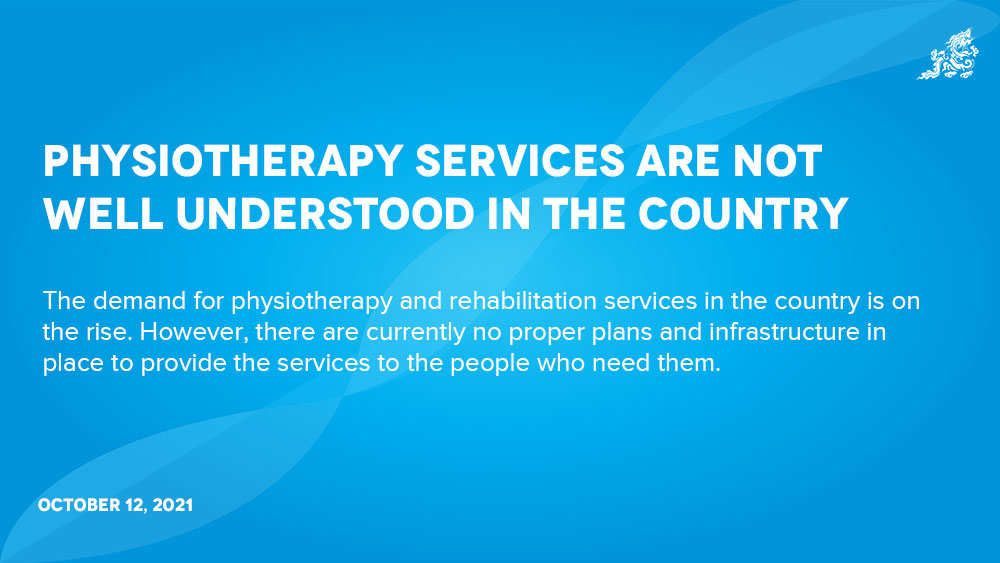Nima | Gelephu
The demand for physiotherapy and rehabilitation services in the country is on the rise. However, there are currently no proper plans and infrastructure in place to provide the services to the people who need them.
According to a commentary published on physiotherapy services in patient care in Bhutan recently, physiotherapy services are not yet recognised as a priority sector, and that the services are yet to be integrated into all levels of patient care.
One of the authors of the report, Monu Tamang, who is a physiotherapist at the Gelephu Central Regional Referral Hospital (CRRH), said that physiotherapy services are provided only in referral and district hospitals in the country today.
“There are multiple factors affecting the reach of physiotherapy services to the communities, including inadequate human resources and infrastructure,” he said.
He added that physiotherapy services are an integral part of any multi-disciplinary healthcare service. “If any component of holistic healthcare is missing, patient care will be incomplete. As a critical component for better outcomes in patient care, physiotherapy services should be prioritised in the health system,” said Monu Tamang.
He said that with socio-economic development and advancements in the healthcare system, the life expectancy of Bhutanese is increasing. “As people live longer, physiotherapy services are necessary to enhance the quality of life.”
Today, both inpatient and outpatient physiotherapy services are provided at the Jigme Dorji Wangchuck National Referral Hospital (JDWNRH) and the two regional hospitals in Gelephu and Mongar. Only basic physiotherapy services are available in the district hospitals.
Gelephu hospital sees about 45 patients requiring physiotherapy services daily, on average.
Monu Tamang said that there are 48 hospitals, 168 primary health centres, and three municipality health centres in the country today. However, physiotherapy services are available in only 26 hospitals across 19 dzongkhags.
According to the report, geographical inaccessibility, human resource constraints, lack of competency assessment for practising physiotherapy professionals, lack of infrastructure, and misconceptions about physiotherapy care are some of the challenges facing physiotherapy services.
Officials said that most patients from villages are unable to receive follow-up care due to distance and the cost incurred in travelling to the health centres. This results in incomplete rehabilitation and readmission to the hospitals with secondary complications.
There are 34 physiotherapists, five on contract, and 68 physiotherapy technicians in the country today. The ratio of physiotherapy professionals to every 10,000 population is 1.4, compared to 5.6 for doctors and 18.4 for nurses today.
Monu Tamang said that with increasing numbers of people requiring physiotherapy and rehabilitation services, current dedicated human resources are inadequate.
Bhutan has only one specialist in physiotherapy.
Attrition of physiotherapy professionals is another major problem, said Monu Tamang. A total of 11 physiotherapy professionals have left the job between 2019 and 2020.
There are also no proper clinical competency assessments from regulatory authorities for practising physiotherapists.
According to the report, the Physiotherapy Department at JDWNRH does not have adequate infrastructure. The two regional referral hospitals lack separate beds for rehabilitation, resulting in the premature discharge of patients and the absence of follow-ups.
The government had proposed in the 11th Five-Year Plan to establish a rehabilitation centre at Gidakom hospital in Thimphu to address the issues. However, the proposal was not approved for implementation, according to the commentary analysing human resource capacity in physiotherapy services in Bhutan.
Monu Tamang said that physiotherapy services were started as passive modalities of treatments such as massage. “The profession still carries that stereotype. For a resource-constrained country like Bhutan, physiotherapy services are essential to replace expensive and low-value care.”
The report published in the Human Resources for Health journal recommends an overall strategic framework and policy to deliver to present as well as future healthcare needs.
Edited by Tshering Palden


